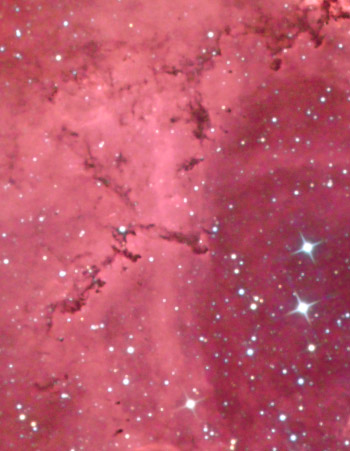| Time Travel Research Center © 2005 Cetin BAL - GSM:+90 05366063183 - Turkey / Denizli | ||||||
|
Rozet Bulutsusu'ndaki Sıcak Yıldızlar
Açıklama : Rozet Bulutsusu'nun içerisindeki büyük kütleli sıcak
yıldızlardan gelen ışınım ve rüzgârlar, yakınımızda yer alan bu yıldız
oluşum bölgesinin merkezindeki doğuma neden olan gaz ve toz bulutunu
temizlemiştir. Bu yıldızlar, ayrıca komşu bölgelerde yer alan daha genç ve
soğuk yıldızların çevresindeki gezegen oluşum diskleri üzerinde de bir
tehlike oluşturuyor. Rozet'in merkez bölgesi yakınlarındaki toz bulutlarının
Spitzer Uzay Teleskobu'ndan alınan bu kırmızı ötesi görüntüsü, temizlenmiş
olan bu boşluğu gösteriyor. Görüntü, bulutsunun 5200 ışıkyıllık tahmini
uzaklığında, yaklaşık 45 ışıkyıllık bir alanı kapsamaktadır. Farenizin
imlecini yapay olarak renklendirilmiş bu resmin üzerine getirdiğinizde,
yüzey sıcaklığı 25.000 kelvinin üzerinde ve tayf sınıfı O olan bu tehlikeli
yıldızlar ortaya çıkacaktır. Gökbilimciler, Rozet'in bu O sınıfı
yıldızlarına yaklaşık 1,6 ışıkyılından daha yakın bir mesafede dolanan soğuk
yıldızların, gezegen oluşum disklerini kaybetme tehlikesi ile karşı karşıya
olduklarını tahmin etmektedirler.

THE ROSETTE NEBULA IN
MONOCER0S
NGC
2244 - EMISSION NEBULA PLUS CLUSTER
This seems to be a wintertime favorite for most observers and long exposures reveal exactly why. The Rosette, NGC 2244, is a spectacular emission nebula strong in hydrogen gases which lends itself well to filtered exposures that bring out the fainter features. The nebulosity engulfs a few star clusters, NGC 2237, NGC 2238 and NGC 2239. This region is a rich area of dust, stars, and nebulosity due to its position in the winter Milky Way. The cluster is easily viewed with any scope in dark skies. The nebulosity is a bit more difficult to see, however, due to the human eye's inability to see such concentrations of hydrogen-alpha light. Thus, you might need a bit more aperture than you think if you expect to see the Rosette shape itself. If you try it, think big...it's actually a much larger object than you'd think, being over a degree wide, or twice the width of our own moon at full phase.
|
|
|
Full resolution detail of the Rosette dust. |
Date:
December 17, 2004
Location: The Ballauer Observatory near Azle, Texas
Transparency: 4.8 mag zenithal
Seeing: 7/10
Temperature: 38 degrees F, camera cooled to -25 degrees C
Scope/Mount: Tak FSQ-106 @ f/5 and Tak NJP mount
Camera: SBIG STL-6303E (Ha info) and SBIG STL-11000 (color
info), self-guided
Filter: Custom Scientific 4.5nm hydrogen alpha spectral line
filter
Exposure Info: Ha (Ha+R) GB, 180:15:40:40 minutes. 15 minutes
subexposures (Ha) and 5 minute subexposures RGB); all unbinned.
Processing: Dark frame calibration, flat fields, registration,
and Sigma Combine in MaxIm DL 4. Digital Development and RGB combine in
MaxIm DL 4. Final HaRGB combine, deblooming, gradient removal, color
balance, curves, levels, selective sharpening/blurring/despeckle in
Photoshop CS.
Astronomi Nebula Resimler Astrophotography Galaxy Resimler Yıldız Resimler
Copyright(c) 2003 - 2006 - Cetinbal - All rights reserved.
